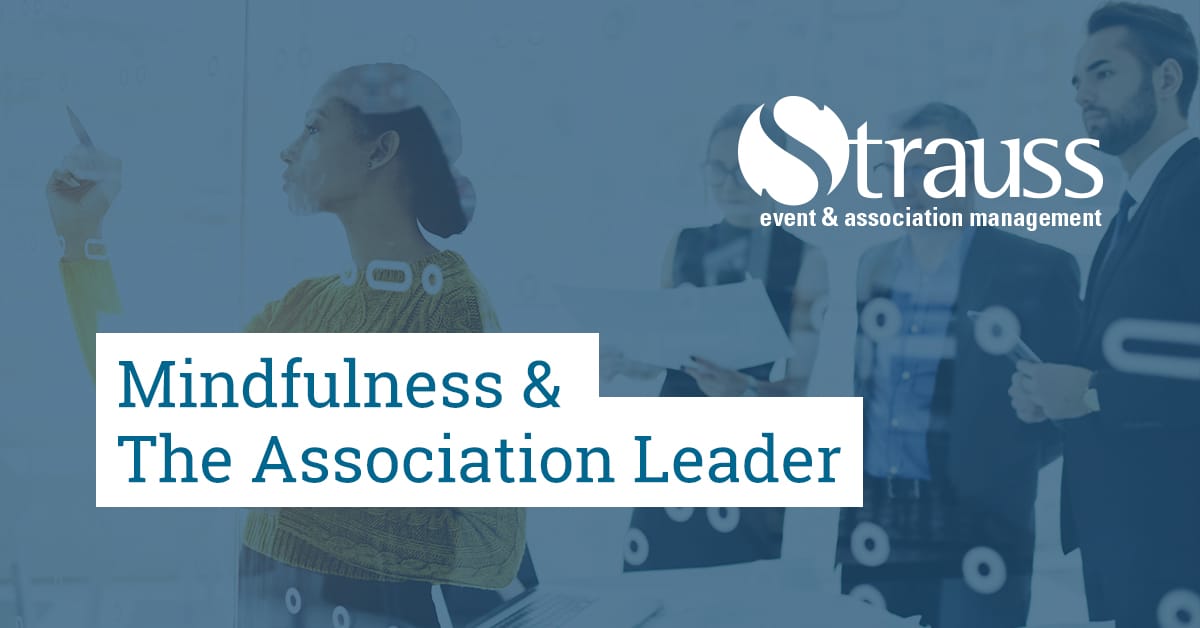We are in the middle of the COVID-19 pandemic; association leaders are undoubtedly going through challenging and unpredictable times. As an association leader, you are dealing with cancelled association events, a postponed AGM, new online platforms for board meetings, events, and webinars, and you are working harder than ever to keep members engaged and involved. How are you personally dealing with all this? How are you managing your own stress so that you can be the leader that your association needs now more than ever? The answer is Mindfulness.
What is Mindfulness?
Mindfulness is a form of meditation, it means maintaining a moment-by-moment awareness of our thoughts, feelings, and surrounding environment. Techniques can vary, but in general, mindfulness meditation involves a breathing practice, mental imagery, awareness of body and mind, and muscle and body relaxation. Practicing mindfulness meditation does not require props or preparation. It teaches one to slow down racing thoughts, let go of negativity, and calm the mind and body. When we practice mindfulness, our thoughts tune into what we are sensing in the present rather than re-living the past or worrying about what the future might bring.
Why Practice Mindfulness?
According to the Greater Good Science Center at UC Berkeley, studies have shown that practicing mindfulness, even for just a few weeks, can result in a variety of benefits.
- Practicing mindfulness can boost our immune system’s ability to fight off illness. It can also improve sleep quality.
- Mindfulness increases positive emotions while reducing negative emotions and stress.
- Mindfulness helps us focus, tune out distractions and can improve our memory, attention, and decision-making skills
Becoming a Mindful Association Leader
The first step to becoming a mindful association leader is to develop self-awareness. How are you showing up for association members? For the board? To continue to be effective, you must ensure that you are checking yourself before an association meeting or call. During challenging times like these, the association looks to leaders for guidance. Leaders can raise their own mindfulness by paying attention to how they are showing up with people and within situations.
Once you become aware of how you are reacting and engaging with members, you can make a plan to improve your awareness and presence. One of the easiest changes a leader can make starts with the five-minute breathing exercise every day. This will diffuse your negative reactions and emotions.
Mindfulness is a proven method to help leaders manage stress. When association leaders are stressed, the anxiety can be felt across the entire association, and the leader can be perceived as ineffective, or even harmful. Incorporating mindfulness into your routine can help reduce stress and anxiety while building healthy coping skills. There are various ways for the association leader to practice mindfulness, and it is most successful when you choose a strategy or activity that works best for you.
How Mindful Leaders Think
According to a Harvard research study, mindful leaders have mastered two ways of processing:
- They are able to personally separate themselves from stressful events and can observe situations objectively.
- They are able to control their reactions to stressful or difficult situations so they can process their options, rather than reacting without thinking.
The Harvard Business Review research identified three specific areas that allow leaders to be more present, more thoughtful in their organizational choices, and more aware of everything going on around them.
The three areas are:
- Metacognition. This is the ability to take a step back to observe at a distance what is happening around you. You become more aware of your own reactions to situations.
- Allowing. This means being open to what is happening without judgement of yourself or anyone else. “Without allowing, our criticism of ourselves and others crushes our ability to observe what is really happening” (Reitz; Chaskalon).
- Curiosity. The most effective leaders have a strong sense of curiosity and are open to learning more about all situations. They welcome the opportunity to gather as much information as possible before making decisions.
Read more about important leadership traits in my colleague’s article, Association Leadership Traits: Do You Have What It Takes to Lead?
How do I get started?
- Start with your breathing – Make sure you are seated in a comfortable chair, feet on the ground, hands resting on your lap, eyes closed. Breath in for 4 seconds, hold it at the top, then breath out for 4 seconds. Repeat this exercise for five minutes daily.
- Take a walk specifically to pause, get some white space and re-charge. Take notice of what you are sensing – the sights, sounds, and smells that ordinarily slip by without reaching your conscious awareness. This is also known a “walking meditation.”
- Recognize that your thoughts and emotions are temporary and do not define you. This insight can free you from negative thought patterns.
There are a lot of great apps that can assist with starting the mindfulness habit. Below are a few links to get started:
- Calm – Free version available in both English and French.
- Headspace – Free content available with the option to upgrade to additional content. Available in English and French.
- Petit Bambou – Free programs available with the option to upgrade to additional content. Available in English and French.
I wish you the best of luck and the most inner peace on your mindfulness journey.

